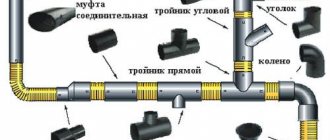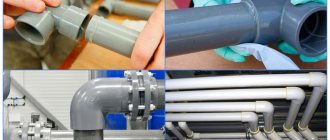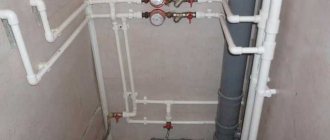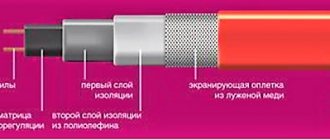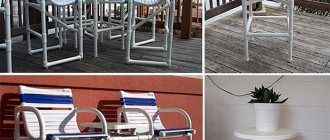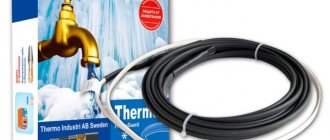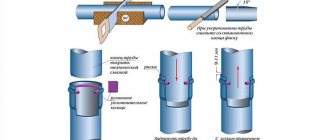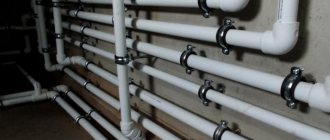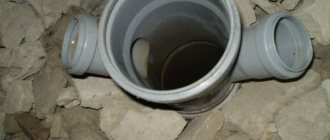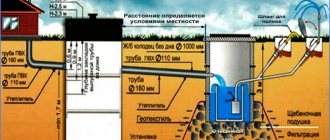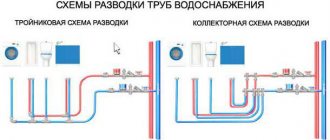What are HDPE pipes?
Polyethylene is a widespread and well-known plastic. But pipes from it began to be made not too long ago - about 50 years ago. The name "low-density polyethylene" comes from the method of production of polyethylene and has nothing to do with the quality of the plastic.
Pipes can be black, bright blue, black with blue and yellow stripes, gray (for sewerage), and rarely other colors. Blue or black with blue stripes products are intended for drinking water supply, black products are for technical purposes. Diameters – from 16 to 1600 mm. Manufactured as measured products 12 m long or in coils (if the diameter does not exceed 160 mm)
Purpose of fittings
As systems are installed, it may be necessary to install the following types of connections, for which a variety of fittings are used:
- Compression fittings;
- Angles designed to change directions;
- Crosses for creating branches in two directions;
- Collectors and tees, which provide the opportunity to multiply flows in the required quantities;
- Couplings for connecting different sections installed in the same direction;
- Adapters, plugs, etc.
Depending on the material chosen for the pipes, the design features of the required fittings are determined. They are divided into threaded, flanged, welded and compression. If you pay attention to the design of the fitting, you can determine the degree of complexity of the upcoming assembly. The shape of the products is practically unchanged and differs only in the quality of materials and the accuracy with which the diameter of the inner rings was selected. When you buy a low-quality product, you may not expect that the installation of the system will be simple and convenient. As you shop, try to check all the parts that make up the product you need. There should be no damage to the housing. O-rings are most often made of rubber. It will not be possible to check the composition used before purchasing it. There is always the possibility of a visual inspection. This part of the part should not be too narrow. The ring should be of medium hardness. In order to check the quality of the connection, try to scroll it with good acceleration. When spinning a high-quality part, the inertia will be small.
Scope of application
HDPE is used exclusively for cold water pipelines, as it can be operated at a temperature of no more than 40 °C. Working pressure – no more than 20 MPa (2 atmospheres). They are used everywhere for laying water supply and sewerage networks underground and water supply systems from a well with a pump.
Wider distribution is hampered by instability to ultraviolet radiation - it will not be possible to completely switch to HDPE.
In addition, communication or power supply cables are laid in smooth or corrugated tubes.
Advantages and disadvantages of these pipes:
The nuances of installation with compression fittings
The joining of pipes or the organization of the necessary network branches is ensured in accordance with the following recommendations:
- The required amount of HDPE pipe should be prepared.
- The compression fittings need to be unscrewed a few turns.
- Preliminary markings are made on the pipe indicating the depth of the water fitting.
- The section of the pipe where the joining will be carried out is lubricated with water or a soap solution.
- The pipe is inserted into the prepared fitting up to the previously created mark. Make sure that the polyethylene pipe fits completely into the sealing ring - this will require some force. If this is not done, the tightness of the connection will not be ensured.
- The cap nut is tightened until the thread ends.
Correct installation of such devices ensures a tight and durable connection.
Advantages
- low cost;
- chemical inertness - does not react with alkalis or acids; the water does not acquire any foreign taste or smell;
- corrosion resistance; resistance to aggressive environments;
- durability - the first pipes have been in service for more than fifty years;
- smooth inner surface - such pipes do not “overgrow” with calcium salts, like metal ones;
- tolerate freezing with water inside and do not burst like metal ones;
- are not afraid of temperature changes (ranging from - 20 ° C to 40 ° C):
- plastic polyethylene easily tolerates soil movements;
- Manufacturability – easy and quick installation;
- polyethylene is environmentally friendly - its production and disposal do not lead to environmental pollution;
- their low weight facilitates their installation, storage, and transportation.
Couplings
The simplest option for connecting two or more polyethylene pipes with equal diameters into long communication lines are connecting couplings for HDPE pipes. During the installation process, the polyethylene pipe is inserted into a special plastic sleeve and firmly fixed there.
HDPE couplings
Then the cover nut is pressed, turning it end to end in a clockwise direction. This connecting element ensures that the pipeline system maintains optimal flow and constant pressure.
Connection methods
Pipes made of low-density polyethylene can be connected in detachable and permanent ways. Below we will talk about each of these methods.
Detachable connections
This type of connection is used on diameters up to 315 mm inclusive, but it is advisable to use on diameters no more than 110 mm. It is as reliable as one-piece methods.
Its advantages:
- speed and ease of installation;
- economical - no special equipment required; couplings and other fittings are not too expensive;
- accessibility - can be used in cramped conditions, under water, for example.
Connectors (fittings, couplings) are mounted in the following order:
- the ends are carefully cut perpendicular to the length of the pipe; cleared of burrs;
- the ends are chamfered (using a special device or a sharp knife);
- a connecting element is placed on the ends (it fits into the adapter quite tightly);
- then carefully tighten the nut on the fitting.
Connection with couplings
This is the fastest way to assemble pipelines and does not require special equipment. Can easily be used at home.
Polyethylene couplings come in several types:
- connecting – connect pipes of the same diameter;
- reduction – used as a transition for different diameters;
- compression – designed for connecting PE pipes with various shut-off equipment, steel, propylene or PVC pipes.
Couplings can be straight or angular. Types of couplings are shown in the table.
Fitting connection
Compression fittings are a type of connecting parts for water pipes.
Installing them is similar to installing couplings.
Flange connection
It is used on large-diameter main pipelines (at least 40 mm) for installing gate valves, valves, regulators (for their subsequent removal for repair or replacement).
To secure the flanges, special couplings are welded to the ends of the pipeline, then the flanges are screwed onto them.
Permanent connections
The only possible method for connecting large diameters.
Butt welding
It is advisable to use this type of welding to connect workpieces with a wall thickness of at least 5 mm.
The ends are cleaned, chamfered, inserted into a special heater, melted, then the workpieces are joined, pressed and held motionless until completely cooled.
Electrofusion welding
The two pipes being connected are inserted into a special coupling, inside of which there is a heating element. Then voltage is applied to it from a special apparatus, the coupling and workpieces are heated and welded. A very convenient welding method. And very expensive. For large diameters, the cost of the coupling will be much higher than the cost of the pipeline on your site.
When performing this type of welding, special attention should be paid to pre-cleaning the ends and keeping the joint stationary until it cools completely.
Selecting the diameter of pipes and fittings
The key parameters when selecting pipes and fittings for water supply are:
- Diameter internal. It should be the same for both pipes and fittings. It is directly dependent on the wall thickness.
- Pipe length.
- Conditional pass. Designated by DN with the addition of the value in mm.
- Wall thickness.
The choice of pipe diameter is influenced by the flow rate. Its nominal value for a standard water supply is 0.02 km/sec. There is the following relationship between the length of the water pipeline and the diameter of the pipes:
- For a system length of up to 30 m, the optimal pipe diameter is 25 mm, which provides a throughput of 30 l/min.
- For installation of a water supply system longer than 30 m, pipes with a diameter of 32 mm are suitable, increasing the throughput rate to 50 l/min.
- For systems less than 10 m long, pipes with a diameter of 20 mm are used.
Important: When choosing pipes by diameter, be guided by the expected water flow, taking into account that the capacity of the kitchen and bathroom faucet is no more than 5 l/min. The more points of consumption, the larger the diameter of the pipes.
The following parameters have a decisive influence on the choice of pipe diameter for a country water supply:
- system length;
- estimated number of joints;
- number of turns;
- consumption rate;
- water pressure.
Keep in mind: with the same diameter of pipes for cold and hot water, the wall thickness of the latter should be 2 times greater.
Step-by-step instructions for connecting HDPE pipes
Required tools and materials
- centralizer;
- hydraulic unit;
- heater with temperature control;
- electric trimmer;
- inserts for various diameters of welded products.
Work progress
- HDPE pipes are clamped in a centering device;
- trimming and chamfering is carried out;
- the ends are degreased;
- surfaces are heated by a welding heater and melted;
- the welding heater is removed;
- the ends are compressed so that a seam bead is formed;
- the pipes are not touched until completely cooled, then the centralizer is removed.
Installation specifics
Sequentially perform insulation work:
To begin with, the coupling is unpacked. Any dirt must be removed from its inside. A cuff is placed in the middle of the joint. The edges are marked there. A heat-shrink sleeve is attached to any joining pipe, leaving a gap of 45-50 centimeters from the edge. Now the pipes are placed in a welded tube so that they are in the same plane.
It is necessary to maintain a small gap between the connecting elements. For welding pipes, use a manual gas or electric torch. You can also use an automatic welding complex. The last option is the most reliable. When welding is completed, you need to wait some time until the joint cools down. When it cools down, the weld is checked for leaks.
For this, an online remote control system is used, the conductors of which are connected to begin the process. If the result is positive when checking the tightness, you can proceed to the attachment of a heat-shrinkable coupling for pipes. It should completely cover the uninsulated areas. At this stage, the cuff is heated with a gas burner. Thermal energy must disperse from the center throughout the product.
The welder begins heating from its lower part. For heat shrinking of couplings, a temperature of 90 to 110 oC is required. In the final stage, the cavity between the pipe and the joint is filled with insulating compounds. They are poured into a special hole.
The second hole is intended for vacuumization of the structure. After half an hour, both holes are sealed with a plug. Its maximum protrusion should not exceed two millimeters.
As the coupling cools, it will begin to shrink in size.
This will increase the tightness of its connection with the pipes. As a result, the thermal coupling will become one with the polyurethane shell. The result will be a 100% sealed joint.
In this case, there is a limitation on overheating of the thermal coupling. This will lead to loss of strength of the product. If a bluish sheen has formed on the surface of the heat-shrinkable coupling for PPU pipes, this is a consequence of overheating.
Expert advice
You cannot connect pipes with a noticeably pronounced ellipse - the quality of the seam will be unsatisfactory.
After welding, the welded unit must remain stationary until it cools completely.
Do not neglect cleaning the ends from soil, dust, sand, shavings and degreasing - these little things significantly affect the quality of the seam.
How to connect a HDPE pipe to a polypropylene pipe
Polyethylene and polypropylene cannot be welded. Correctly connect them together only using fittings. On the ends to be connected, you should weld or put on MCVs (couplings with internal threads) made of the appropriate material, screw a quick-disconnect threaded connection (“American”) onto one MCV, then connect two MCVs using a union nut.
How to join polyethylene and steel pipes
This joining is carried out similarly to the joining of HDPE and polypropylene. A steel pipeline usually ends with a thread. You can use the drive instead of the American one - but this option has already become obsolete.
On large highways, a valve or gate valve is usually mounted at such joints - in this case, a flange connection can be used.
Required characteristics
It is impossible to determine the most suitable products for an application, if you plan to do the assembly yourself, be sure to consider the factors below. The most common parts are 15-110 mm in size. These characteristics are due to the fact that it is not easy to find pipes with lower values when it comes to diameter. The dimensions dictate the properties of the material because HDPE pipes must have the necessary stability, and the walls must always be strong. Naturally, the diameter must be sufficient for cross-country ability, which leads to the mentioned trends. Fittings with a diameter of more than 110 mm are rarely used in private construction. These products are designed to withstand high temperatures. It must be taken into account that when installing pipes with a diameter of no higher than 63 mm, technologies require calculating pressures above 16 bar, and if the values are too high, you should not cross the 10 bar mark.
It is necessary to carefully inspect the product and read the certificate, which specifies production standards. The possibility of use for drinking water is confirmed by the corresponding conclusion, which is issued based on the results of a hygienic examination. Check its availability if you intend to use the fittings in the specified type of water supply. It is imperative to pay attention to the selected products. Are they suitable for the type of pipe used in all respects and do they correspond to the upcoming loads? The specified pressure parameter is focused specifically on the operating loads that the fittings must withstand during the period of operation. An insignificant increase does not entail destruction of the water supply system, but will significantly reduce its service life.
To ensure that the installation process takes as little time as possible and is carried out without mistakes that will not be easy to correct, you need to pay attention to the following subtleties:
- Check that you have a sufficient amount of necessary materials and related products;
- Draw up a plan according to which the system will be installed;
- Make markings and cutting.
After this, you should proceed to the main installation stage.
